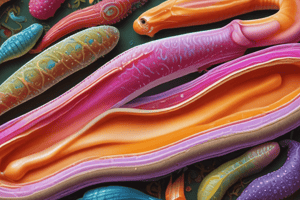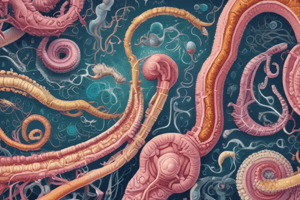Podcast
Questions and Answers
What is the size range of a male Schistosoma haematobium worm?
What is the size range of a male Schistosoma haematobium worm?
- 0.5-1 cm
- 3-3.5 cm
- 1-1.5 cm (correct)
- 2-2.5 cm
Where is the ovary located in a female Schistosoma haematobium worm?
Where is the ovary located in a female Schistosoma haematobium worm?
- Anterior third
- Posterior third (correct)
- Throughout the body
- Middle third
Which snail genera can act as hosts for S.haematobium?
Which snail genera can act as hosts for S.haematobium?
- Oncomelania and Biomphalaria
- Lymnaea and Planorbis
- Achatina and Helix
- Bulinus and Physopsis (correct)
What is the morphology of eggs of Schistosoma haematobium?
What is the morphology of eggs of Schistosoma haematobium?
Where is it recommended to avoid swimming to prevent Schistosoma haematobium infection?
Where is it recommended to avoid swimming to prevent Schistosoma haematobium infection?
In which age group is the peak prevalence of S.haematobium infections?
In which age group is the peak prevalence of S.haematobium infections?
Where is Schistosoma haematobium endemic?
Where is Schistosoma haematobium endemic?
Which disease is caused by Schistosoma haematobium infection?
Which disease is caused by Schistosoma haematobium infection?
Where do Schistosoma haematobium worms live in humans?
Where do Schistosoma haematobium worms live in humans?
Malaria is caused by multi-celled protozoan parasites.
Malaria is caused by multi-celled protozoan parasites.
Plasmodium falciparum is the predominant malaria parasite in Asia and South America.
Plasmodium falciparum is the predominant malaria parasite in Asia and South America.
Plasmodium vivax is mainly found in Africa.
Plasmodium vivax is mainly found in Africa.
Malaria is only present in tropical regions.
Malaria is only present in tropical regions.
In 1993, an estimated 100 million people were infected with malaria.
In 1993, an estimated 100 million people were infected with malaria.
Malaria is not a significant cause of death in Africa.
Malaria is not a significant cause of death in Africa.
Tourists are not considered to be at high risk of contracting malaria.
Tourists are not considered to be at high risk of contracting malaria.
There are no strains of Plasmodium falciparum resistant to antimalarial drugs.
There are no strains of Plasmodium falciparum resistant to antimalarial drugs.
The alternative drugs for malaria treatment are cheap and safe.
The alternative drugs for malaria treatment are cheap and safe.
Malaria is caused by bacteria.
Malaria is caused by bacteria.
Study Notes
Cestodes (Tapeworms)
- Taenia saginatum, Taenia solium, Diphyllobothrium latum, and Hymenolepis nana are species of flatworms that can reside in the human gastrointestinal tract.
- Taxonomic classification of cestodes: • Domain: Eukarya • Kingdom: Animalia • Phylum: Platyhelminths • Class: Cestoda • Order: Cyclophyllidea • Family: Taeniidae • Genus: Taenia • Species: Multiceps, Serialis, Brauni, Glomerata
- Taenia is a genus of tapeworms that includes important parasites of livestock, responsible for taeniasis and cysticercosis in humans.
Taenia saginatum and Taenia solium
- Life cycle: • Eggs of T. saginatum pass in the feces of an infected person and are only infectious to cattle. • Humans are infected by ingestion of raw or undercooked beef infected with Cysticercus bovis, the larval stage of T. saginata. • In humans, the adult tapeworm develops in the intestine over 2-3 months.
- Prevention and control: • Avoid ingesting soil that may be contaminated with human feces. • Wash hands with soap and warm water before handling food. • Teach children the importance of washing hands to prevent infection. • Wash, peel, or cook all raw vegetables and fruits before eating, particularly those that have been grown in soil that has been fertilized with manure.
Ascaris lumbricoides (Ascaris)
- Ascaris is a parasite that infects approximately 807 million to 1.2 billion people worldwide, classified as a soil-transmitted helminth (STH).
- Prevention and control: • Avoid ingesting soil that may be contaminated with human feces. • Wash hands with soap and warm water before handling food. • Teach children the importance of washing hands to prevent infection. • Wash, peel, or cook all raw vegetables and fruits before eating, particularly those that have been grown in soil that has been fertilized with manure.
Cryptosporidiosis
- Cryptosporidiosis is a diarrheal disease caused by the parasite Cryptosporidium, found in contaminated water, food, soil, or surfaces.
- Transmission: • Faecal-oral route (person to person and animal to person) • Ingestion of contaminated foods and water
- Prevention: • Wash hands with soap and water after using the bathroom and changing diapers, and before handling or eating any food. • Do not swallow water while swimming. • Cryptosporidium is chlorine-resistant and can survive in properly treated swimming pools for days.
Mosquito Life Cycle
- Larvae of Mansonia do not need to come to the surface to breathe, as they can obtain air by inserting the siphon into a water plant.
- The larval period lasts about 4-7 days, or longer if there is a shortage of food.
- The fully grown larva then changes into a comma-shaped pupa, which does not feed and spends most of its time at the water surface.
- The pupal period lasts 1-3 days in the tropics.
- The entire period from egg to adult takes about 7-13 days under good conditions.
Studying That Suits You
Use AI to generate personalized quizzes and flashcards to suit your learning preferences.
Description
This quiz covers the taxonomic classification of cestodes, specifically tapeworm species like Taenia saginatum, Taenia solium, Diphyllobothrium latum, and Hymenolepis nana. Learn about their scientific names and different taxonomic levels in the classification hierarchy.



